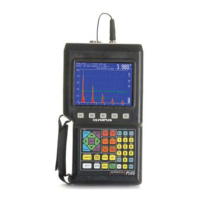Using the Gates
Part # 910-250C
49
These symbols represent the following distances:
= angular (soundpath) distance to the reflector
= surface distance (projection) to the reflector
= depth to the reflector
= soundpath leg that the particular reflector is located in –
1st, 2nd, 3rd, 4th, beyond 4th
The selection of the Measurement modes (Peak Depth or Edge Depth) and the
appropriate soundpath reading type are displayed in large text. See Taking Thickness
Readings on page 2.
Any signal breaking the gate threshold generates the display of soundpath data.
To setup information in the first leg of the soundpath, follow these steps:
1. Enter a value of 0.00 for material thickness when calibrating.
2. Press [2nd F], [ANGLE] (THICKNESS).
3. Press [F1] or use the [] key until the thickness value reads 0.00. With this set-up, all
soundpath data is treated as if the information is in the first leg.
When working beyond the first signal segment, it is important that you enter an exact
thickness of the material into the EPOCH 4PLUS via the thickness setting. Press [2nd F],
[ANGLE] (THICKNESS) and use the [], [], [], and [] keys to enter the proper
thickness. You can also use the function keys to quickly select preset values. This value is
then used to calculate the depth to a reflector that lies beyond the first leg.
6.6 Measuring Signal Amplitude
When estimating discontinuity size, the instrument is adjusted so that a particular gain
setting and screen height represent the echo amplitude produced by a known size reflector
in a reference standard. In general, a signal with smaller amplitude may indicate a smaller
reflector and a signal with higher amplitude may indicate a larger reflector than the
reference standard.
Press [DEPTH/%AMPL] and then [F3] to display a direct on-screen readout of
amplitude information.

